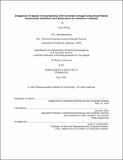Integration of Spatial Transcriptomics with Chromatin Images Using Graph-Based Autoencoder Identifies Joint Biomarkers for Alzheimer’s Disease
Author(s)
Zhang, Xinyi
DownloadThesis PDF (18.14Mb)
Advisor
Uhler, Caroline
Terms of use
Metadata
Show full item recordAbstract
Tissue development and disease lead to changes in cellular organization, nuclear morphology, as well as gene expression. Spatial transcriptomic technologies, such as STARmap and 10x Visium, allow the joint measurement of these different modalities in whole tissue sections.1,2 However, methods for jointly analyzing the different spatial data modalities in 3D are still lacking. We present a computational framework to integrate Spatial Transcriptomic data using over-parameterized graph-based Autoencoders with Chromatin Imaging data (STACI) to identify molecular and functional alterations in tissues. STACI represents multiple data modalities with a single joint representation, which allows for the simultaneous incorporation of the different modalities in downstream tasks, such as the clustering of cells and the identification of disease-associated gene expression and nuclear image features. The joint representation also enables the prediction of spatial transcriptomic data from nuclear imaging data in unseen tissue sections. STACI uses over-parameterization as a technique to integrate different samples and provide built-in batch correction with regard to gene expression and tissue morphology. We apply STACI to analyze the spatio-temporal progression of Alzheimer’s disease in a mouse model. Importantly, we identify nuclear morphometric features such as chromatin condensation as well as coupled gene expression features that are differentially associated with disease progression in different regions of the brain cortex. Collectively, we demonstrate the importance of characterizing cell states and disease progression by integrating multiple data modalities and its potential for the discovery of novel disease biomarkers.
Date issued
2022-05Department
Massachusetts Institute of Technology. Department of Electrical Engineering and Computer SciencePublisher
Massachusetts Institute of Technology